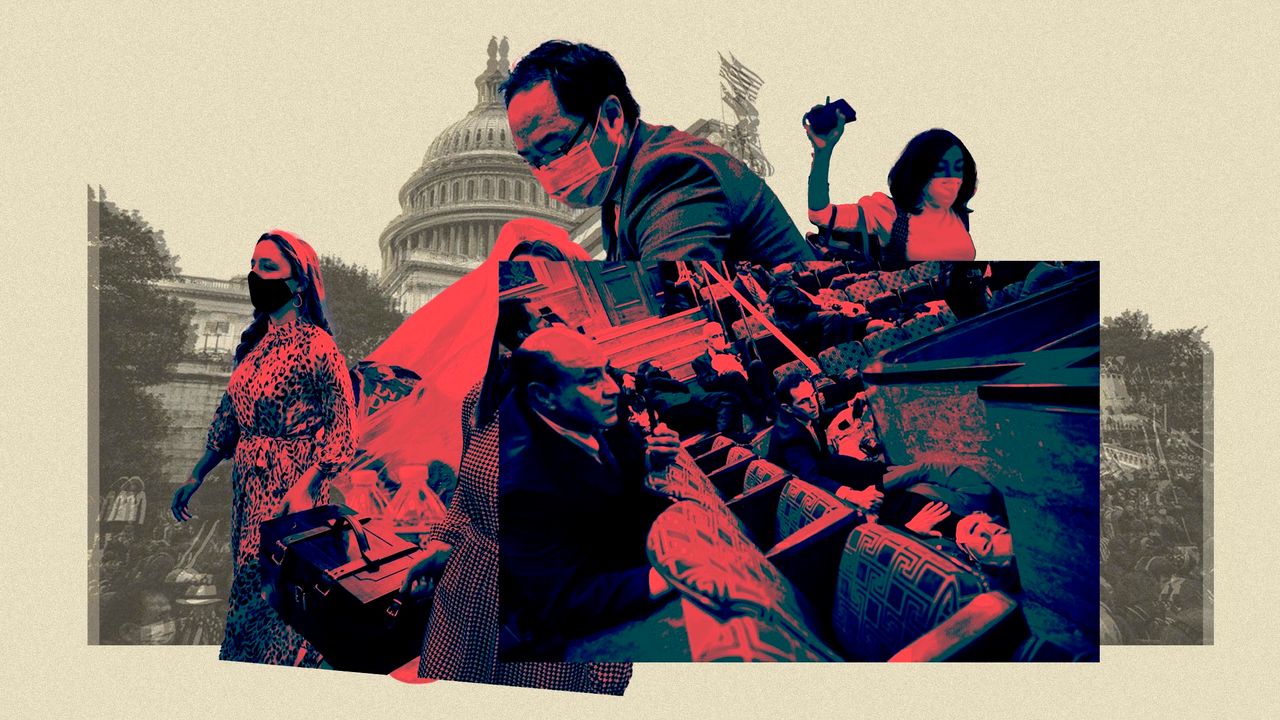We all know the images from Jan. 6: a mob of angry Donald Trump supporters shattering the windows of the U.S. Capitol, fighting police officers and taking over lawmakers’ offices.
But there were also the pictures that showed the other side, of what it was like for the people who were inside the building that day doing their jobs. We saw the fear of being stuck in your office as you hear the mob getting closer, and we saw acts of courage and humanity.
HuffPost spoke to four individuals who were at the Capitol on Jan. 6, 2021, and found themselves in pictures that went viral — sometimes in ways that went beyond their control. Some of them have spoken to the media very little, if at all, about what happened that day.
What’s clear is that what happened at the Capitol is still very present for those who lived through it. Even a year later, they’re still processing their emotions and figuring out what it all meant, both for them personally and for the country.
These interviews have been edited and condensed for clarity and length.
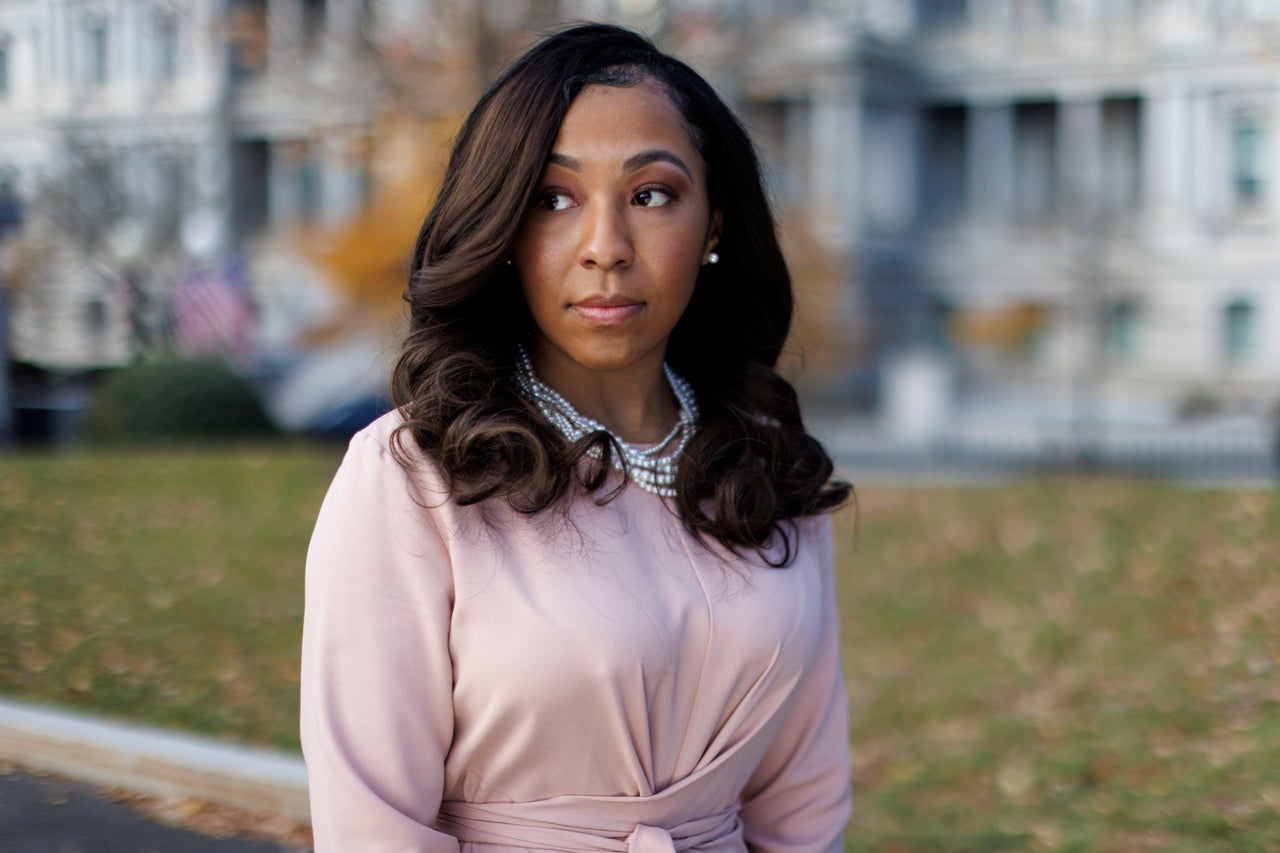
Erica Loewe
Erica Loewe, 32, works at the White House as director of African American media. But last year, on Jan. 6, she was still an aide for Rep. Jim Clyburn (D-S.C.). Loewe was in two of the most widely shared pictures of staffers from that day. In one, she was helping to barricade a door, and in another, she was walking down a hall with her hands in the air.
Q: There are two pictures of you that spread very widely. What was happening in them?
Loewe: We initially went in the office and decided that it was best that we exit out two by two. So two of my colleagues went out. They quickly came back, and they were banging on the door and they were like, [the rioters] were inside. We realized we needed to barricade ourselves in here, because it was safer to be in here than it was to be out there.
Q: What were you feeling?
Loewe: I think I was in a state of shock, to be honest. I was absolutely terrified. Looking back at the text messages ... to my family and friends, I just asked them all to pray because I really didn’t know what was going to happen. I don’t think I truly understood the gravity of what happened until afterwards, when I saw the images.
Q: And then there were photographers who were sheltering there with you, which is how the picture was taken?
Loewe: My former office was pretty close to the House floor. And there were obviously lots of photographers and reporters around, and they asked if they could come with us. Everyone was scared, and we let them in.
But to be clear, we did not intend for them to [take] those pictures. In one of those pictures, you see me looking up. It’s because I’m asking them to help us push the table against the door. But I get it.
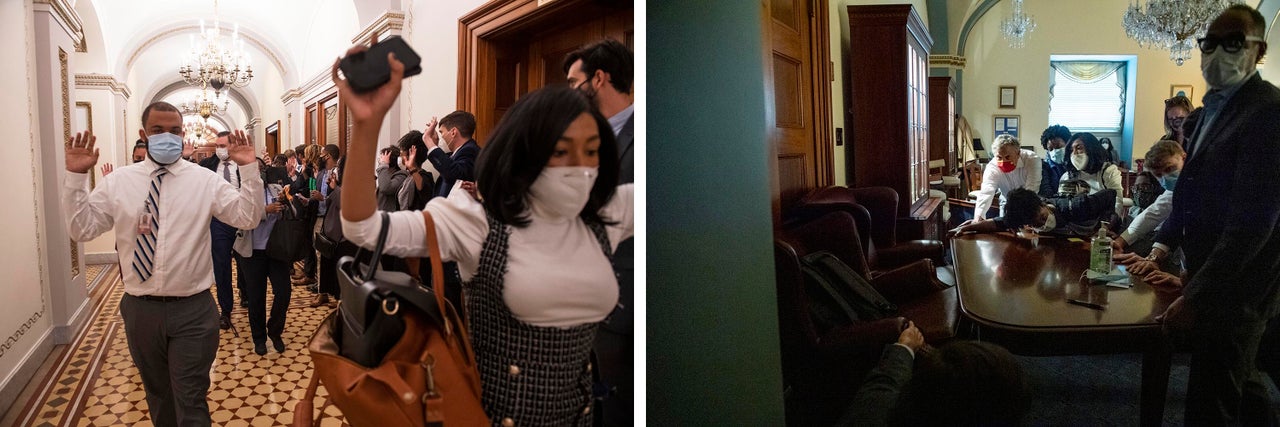
Q: So the one of you when you’re walking out — that one came after, when you were leaving?
Loewe: That one came after. I think you saw a lot of pictures circulated of guns drawn on staffers. It’s frankly because we didn’t know who was outside the door, and the police didn’t know who was inside the door. So when they finally got in, guns were drawn, hands were up, and we were being escorted to the holding area as they were clearing out the Capitol.
Q: Were you nervous to come into work on the Hill at all after that?
Loewe: A little. I chose to continue coming in because I believed in the work that I was doing. It really was like a full-circle moment from then until now.
At the time, I was pushing a table against the door, working for the highest-ranking African American in Congress, who has dedicated his life to civil rights, during what felt like a very personal and racially charged riot. Obviously, democracy prevailed, and we came back, and we certified those votes. And we lived to tell the story and see another day.
Now, I get to work for a president and a vice president who have prioritized racial equity in a way that no other administration has, and my job is directly tied to it. It doesn’t get better than that for me.
I go from pushing a table to now working every day to make sure diverse voices have a seat at the table and have access to information at the highest levels of government.
Q: If you don’t mind me asking, did you ever have any nightmares about Jan. 6?
Loewe: Yeah, for sure. One hundred percent. The first few weeks, months, were rough. I ― and I know a lot of other people ― sought professional counseling just to talk through it. I talked to a lot of my friends and colleagues who experienced it as well.
But yeah, there were definitely moments, walking to my car where ― I mean, obviously you know it’s fine, and I had the utmost confidence in the leadership … and that we were protected, but you can’t help but sometimes have those moments where you’re in a desolate part of the Capitol or somewhere where it’s not highly populated and think maybe someone’s in the corner.
Q: After Jan. 6, did people ― like friends or family, maybe people who aren’t in politics ― want to talk to you about it all the time? Was that OK?
Loewe: All the time. I think I said something on social media the day after because all those pictures were published. I thanked folks for their prayers and reiterated that democracy has prevailed. But no, I did not want to keep reliving it and rehashing it.
My phone basically froze. I thought it was going to blow up because I had so many hundreds of text messages and voicemails, and it just got to the point where I stopped responding and calling folks back. It was too much. Obviously, we got tons of interview requests, and I never took them. Until now.

Q: As you’ve thought about Jan. 6 over the past year, have your thoughts about it changed at all?
Loewe: I think my two big takeaways are that democracy is fragile, and democracy prevailed. An image that I don’t know was broadcast much ― but outside of Majority Leader Steny Hoyer’s office was a poster memorializing John Lewis, and he has a quote about getting in “good trouble.”
When it really hit me what happened was when we were walking out with our hands up, and we passed Mr. Hoyer’s office and that poster was ripped to shreds. That’s when it really struck me what happened and how personal this was and how racially charged it clearly was.
I guess I’m just grateful not only that I made it out, but then I’ve gotten to work for people that get it and who have dedicated their lives to making sure that stuff like this doesn’t happen anymore.
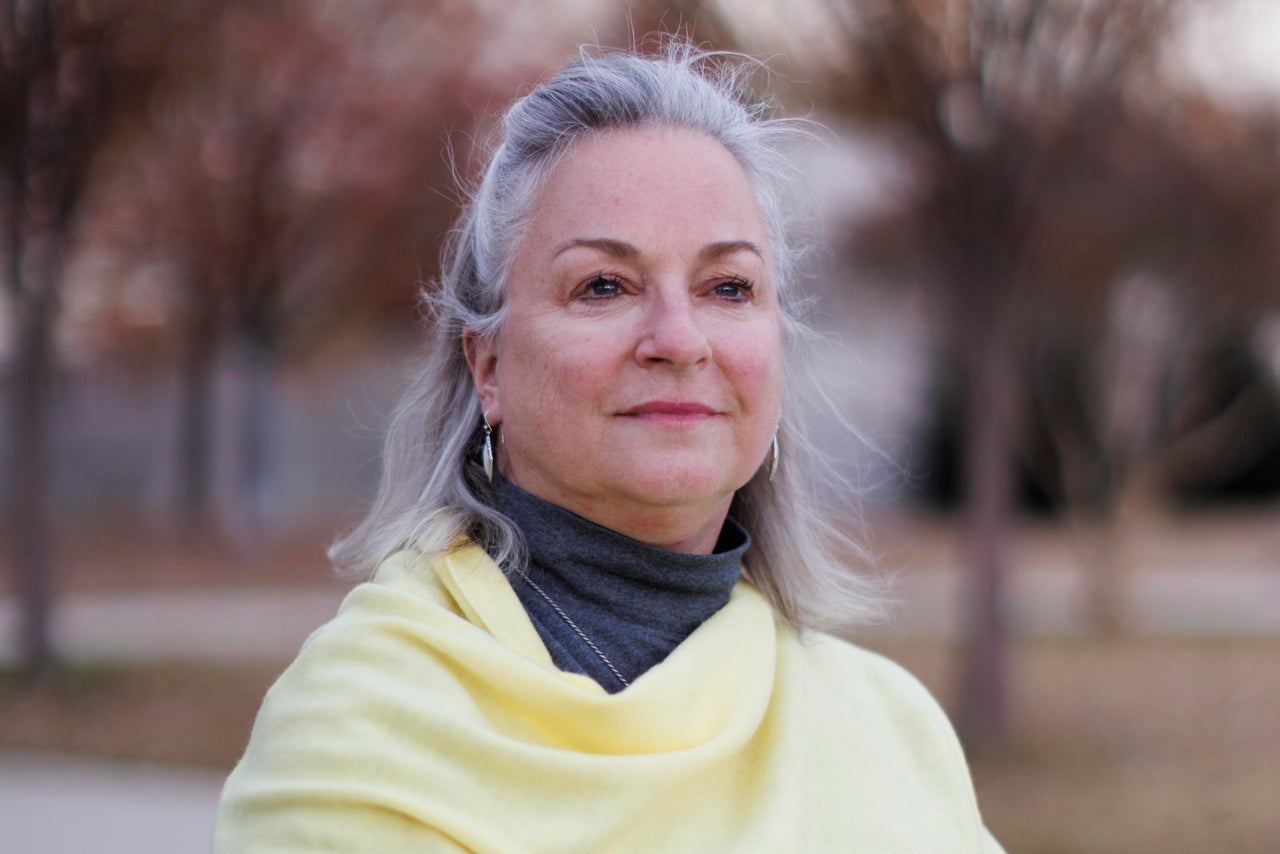
Rep. Susan Wild
Rep. Susan Wild (D-Pa.), 64, was one of the last members remaining in the House chamber on Jan. 6. She heard the sound of glass breaking as rioters came closer. In a picture that went viral, Wild was lying on the floor in distress, with Rep. Jason Crow (D-Colo.) assisting her. At the time, she thought she was having a heart attack but has since learned it was likely a panic attack.
Wild: The picture that went viral was taken on the opposite side of where I had been sitting. It was taken when the drama was ... well underway. We had been directed to traverse to the other side, which is where the only exit door was because all the other doors had been barricaded. And that was kind of harrowing and complicated ― just walking around the gallery.
We were almost to the exit door, the last group of us, and all of a sudden they slammed the door shut. That was right at the same time that we started hearing gunshots down below on the floor, glass breaking on that door that leads out into the corridor.
Up until then I had been fairly stressed, but not as much as I was at that moment. We were so close to getting out, and then all of a sudden they stopped us. I thought I really needed to connect with my kids. My kids are in their late 20s.
My son says I FaceTimed them. I don’t really think I did because I’m not a very good FaceTimer, but anyway, either I FaceTimed them or they FaceTimed me. I was on my phone, crouching, and the whole time they were telling us to stay down, stay down.
So I’m down, crouching, looking at this picture of my kids. We had a very brief but upsetting conversation. And I got off the phone with them because I wanted to be in a position to really be able to move the second they opened that door again.
And then I felt what I’ve since been told professionally was a panic attack, but I thought I was having a heart attack.
Q: And you were near Rep. Jason Crow?
Wild: Jason had come back around. He had actually been way ahead of us. Being the hero he is, he had made a point of coming back into the gallery so that he would be the last one out because his military training kicked in. So he was right behind me at that point in time. Rep. Lou Correa was one row above me. And they were both saying comforting things.
Jason took my hand, and I remember looking up, and there was this big old camera aimed right at me. The Capitol Police almost tackled the photographer. And I guess that’s the photographer who took the picture.
I remember thinking that it was strange that Lou and Jason knew that I was upset. I didn’t realize that I showed that I was upset.
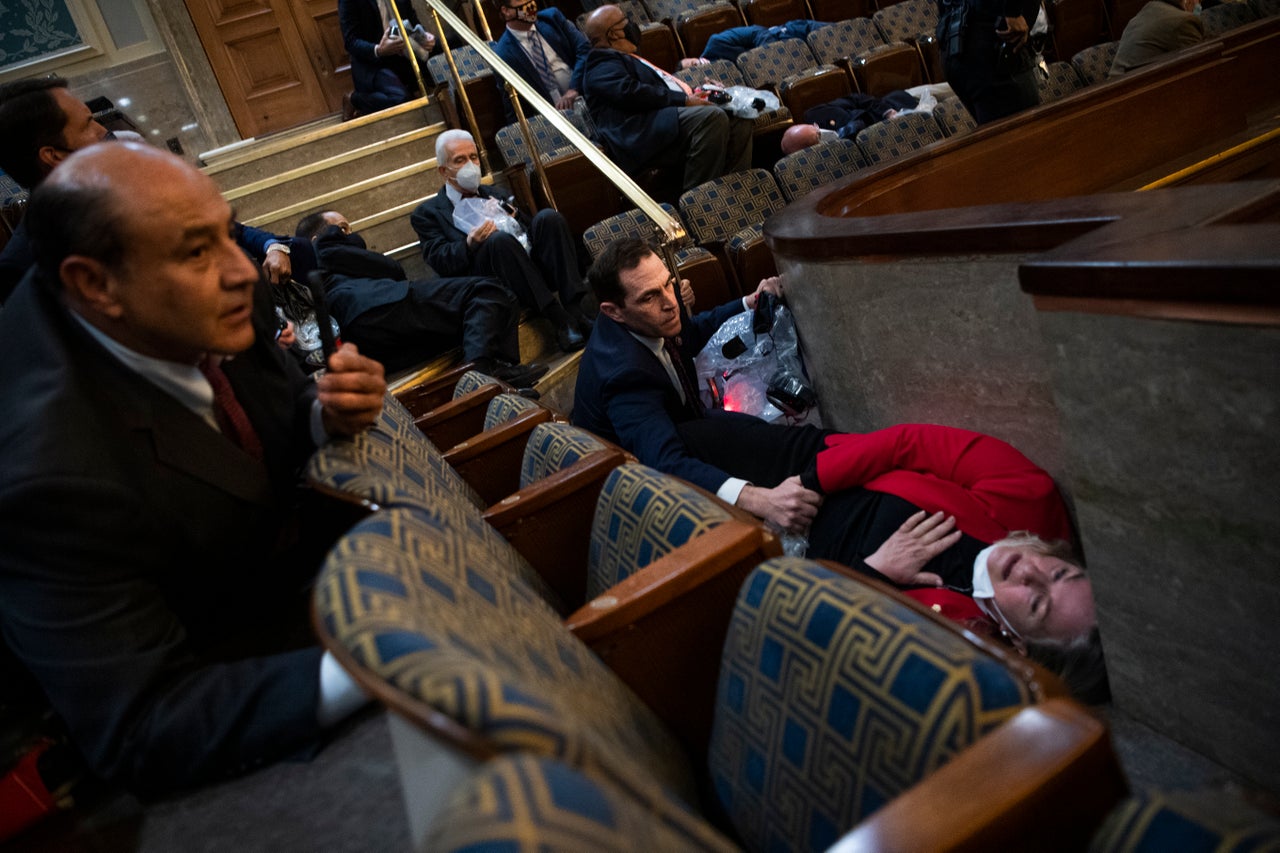
Q: What did you think when you saw that picture going around?
Wild: I was down in the safe room with all the other members, and by then I had established contact with my kids and my family. My son texted it to me. We have a family text thread, and he had texted all of us and said, “Mom, I think you better see this before it goes viral.”
And I just remember thinking, “Oh, my God, how did that get out there so fast?” When I saw it, I remember being really shocked because I didn’t realize that I was almost lying on my back. I still remembered being crouched over.
Q: Did you hear from a lot of people when that picture started to get out more?
Wild: Members who were in the safe room started coming over to me: “Did you see this?” Yeah, I saw that. And then I started hearing from friends, family. I started literally hearing from people that I don’t think I’ve heard from since high school. To this day, I have never cleared all of my texts out of my phone since Jan. 6. I still have literally hundreds of unread texts that I just gave up trying to get through them all.
Q: How often have you thought about what happened that day since then?
Wild: I think I’ve seriously compartmentalized that whole experience, more so than a lot of my colleagues. There is a group known as the “gallery group” ― those of us who were stuck up there together. We’ve all bonded, and we have a private Signal thread and we get together socially once in a while.
I feel like part of my coping mechanism has been that I just don’t think about it. It’s interesting ― a few things will trigger it. Certain people on the other side of the aisle will trigger it. Rep. Lauren Boebert triggers it because she was the last person speaking on the Republican side before the shit hit the fan, so to speak. So even though she would probably trigger me anyway, she particularly does when I hear her speaking on the House floor.
I’ve never been particularly good in crowded places. I’m much worse now.
I wouldn’t say I think about it on a daily basis. In fact, if anything, all this coverage of the Jan. 6. committee ― I almost never read the coverage of that. I did watch the police officers who testified because I thought that that was really important. Remember, we didn’t have TVs in the chambers. So everybody saw what was going on, but we didn’t. So it wasn’t until later, when I watched some of these police officers being brutalized, literally, that I started to realize that they were the only thing between us and these ... insurrectionists.
It just is not something that I really want to relive. Although there are people who think I need to do a better job of dealing with what happened that day.
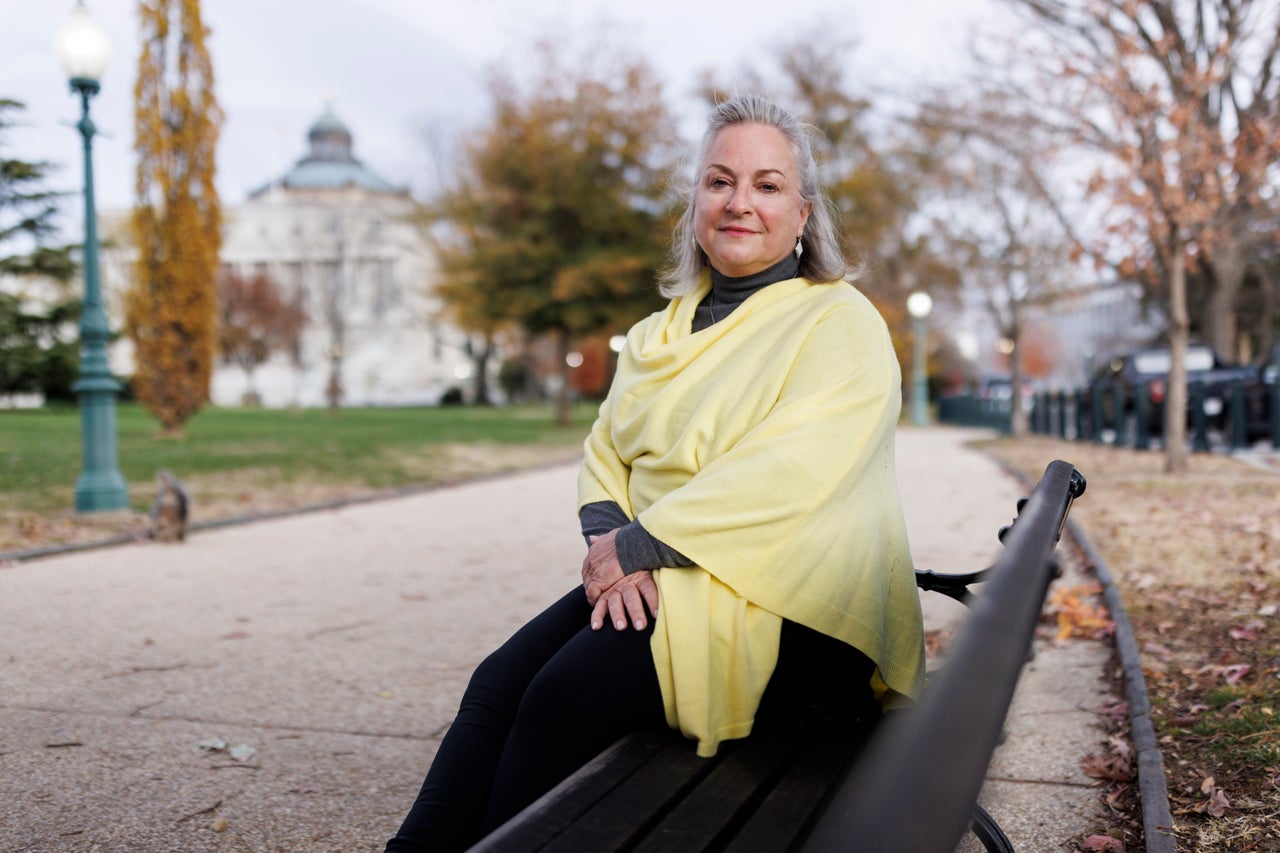
Q: How has, if at all, your view of politics changed because of Jan. 6?
Wild: The follow-up has changed my view. I have been dismayed by this ― almost mocking the experience. Acting like no it was no big deal, acting like these were patriots who came to save our country. If there was ever anything that I thought we could come together around, it would be a full-out attack on the U.S. Capitol where we all work.
I do not talk to any Republican colleagues about Jan. 6, because I feel as though it would get in the way of me doing the work with them that I need to do on substantive policy things. And I don’t think I want to hear what they have to say.
And I don’t really speak to many people about it. The only people I really speak to about it are the members of the gallery group and a professional that I occasionally talk to about it. And my family ― although that’s hard too because it’s really hard for my kids.
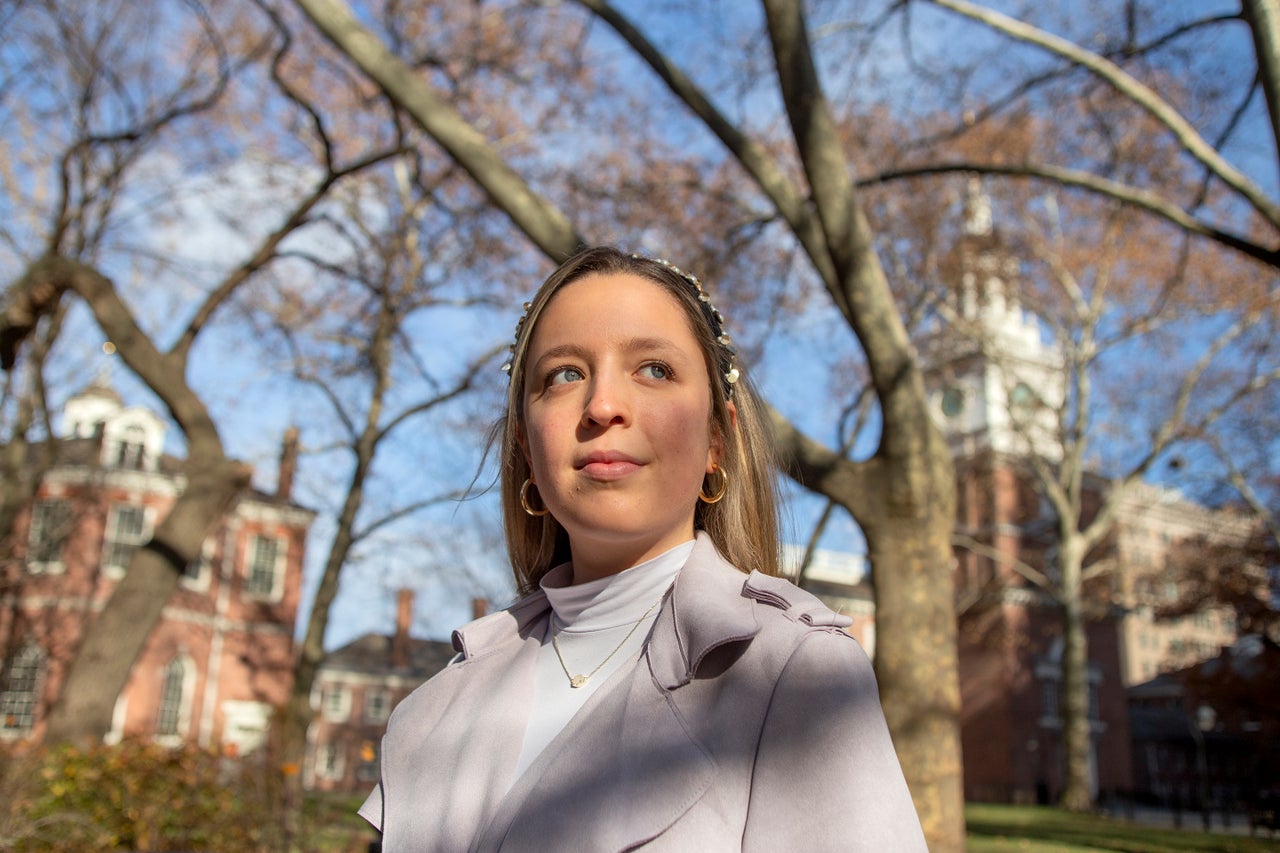
Brennan Leach
Brennan Leach, 20, is a sophomore in college. She was serving as a chamber assistant on Jan. 6, part of a special program set up during the COVID-19 pandemic while the Senate page program was suspended. She helped the Senate Democratic Cloakroom with administrative and other floor duties. Leach went viral in a photo that showed her carrying the Electoral College votes through the Capitol. But the picture didn’t depict exactly what people thought it did.
Leach: We got a message a few weeks prior to Jan. 6 that there was this exciting update: We were going to get to participate in this really historic moment of the ballots being carried from the Senate floor to the House floor. That is something that I’ve always seen pictures of Senate pages doing throughout the years. I was thrilled. I really had no idea at the outset that that was going to be something potentially dangerous, let alone what ended up taking place.
Q: The picture of you that went viral ― I know there was some misunderstanding about it. You weren’t saving the votes from the crowd. So when did you realize that people were sharing that picture so much, and what were your thoughts as people were confused about what was going on?
Leach: It was the craziest situation that I’ve ever experienced. I was among friends, waiting for the attack to conclude, and I had my phone thankfully. At the time, it was just a lot of messages asking about my safety, and my family desperately trying to get ahold of me.
But before we even went back to the Capitol, someone texted me that this famous author, Glennon Doyle, had shared this picture on Instagram and you’re in it. And you saved democracy! And I was like, well, that’s news to me. I have no recollection of that.
I checked, and it was a post that had already gathered tens of thousands of likes. I didn’t have the emotional capacity to focus on that. I let it go and thought I would deal with it later.
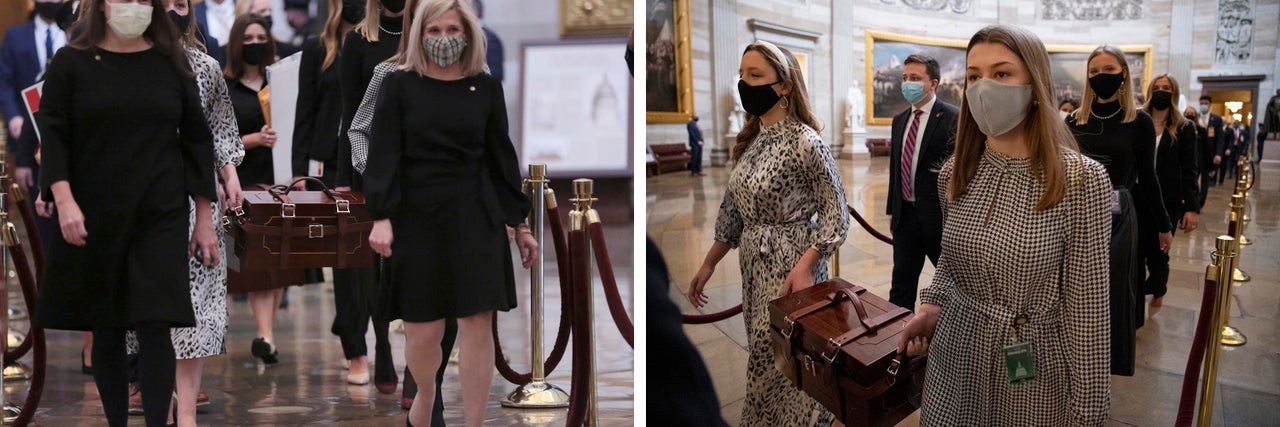
But by the time we got back to the Capitol, my direct messages on Instagram were filled with people reaching out not only on a personal level, but also people representing news outlets. The very first message that I received was from “The Ellen DeGeneres Show.”
When we got back to the Capitol, I had to continue doing my job through like midnight or 1 in the morning. But I would periodically check my phone and each time there would be 50, 100, 150 more requests on Instagram.
My family was messaging me that news organizations were reaching out to them because I wasn’t responding fast enough. And that’s when it hit me like, OK, there is some sort of really powerful, compelling narrative that’s attached to this photo that I need to figure out.
And that’s when I looked into it and discovered that people believed I was rescuing ballots after the attack had begun, when in reality, the photo was taken hours prior, during the normal procession from the Senate to the House floor.
Q: So did you go on Ellen’s show?
Leach: I did not. So much of that day had to do with safety and proper precaution, and there was so much that needed to be figured out about what went wrong and how to learn from that.
At the time, I was living alone. I went home that night at 2 in the morning to my studio apartment. And I woke up in the morning to dozens of phone calls from reporters. That’s in addition to messages on Instagram, Facebook, LinkedIn. I was in way over my head. And admittedly, I did not know how to best handle it.
I felt this great sense of urgency to clarify that this photo was taken out of context. I felt that I was getting unjust praise. People were Venmo-ing me money out of gratitude for me saving democracy. Both the other girl in the photo and I felt a great responsibility to clarify that that was not the case. But it was a very difficult line to walk in terms of setting the record straight and not overstepping in terms of my role with communicating with the press.
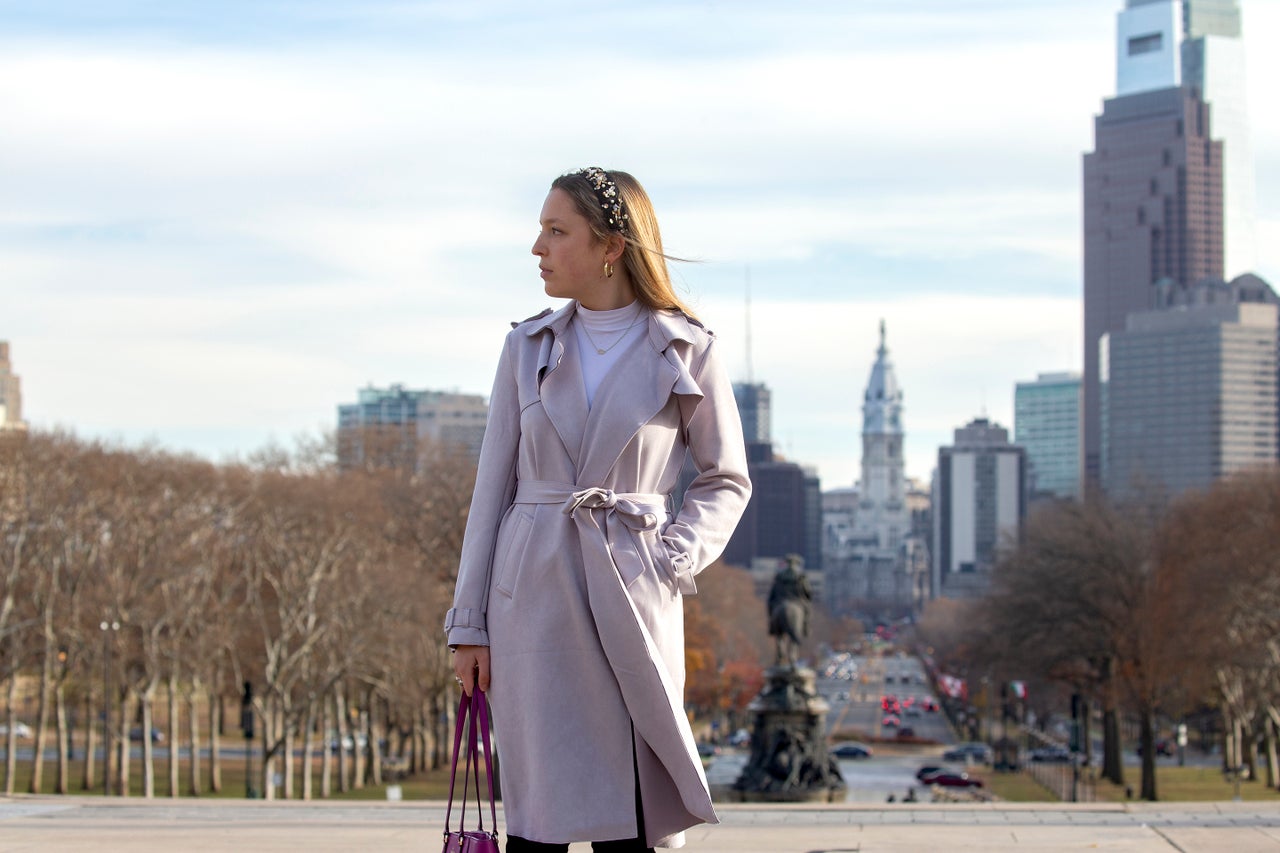
Q: How much have you thought about that day in the past year?
Leach: I honestly think about Jan. 6 every day. I think there were so many layers to my experience that day that will take a long time to fully unpack and put into context in terms of the story of my life and my experience there.
On a personal level, it’s very disorienting to be suddenly in a position where you feel like you have no control. Even controlling my own narrative that day was completely out of my hands. I’m hoping by talking to you and reflecting on that time as I get older, I’m able to take back the reins a little bit on what happened for me, and try to discern what happened to the country and where we go moving forward.

Rep. Andy Kim
After the riot subsided and lawmakers returned to the Capitol to certify the Electoral College results, Rep. Andy Kim (D-N.J.), 39, took a walk through the building and began picking up the debris from the day. It wasn’t planned, and he didn’t expect to be photographed. But pictures of him cleaning up from the riot went viral, showing a moment of quiet decency in a day full of hate. Over the summer, the Smithsonian asked him to donate the blue suit he wore that day to the institution, and he obliged.
Kim: We were back in the House chamber to start voting on the Electoral College count. After we finished the first of the votes, I looked at the center doors of the House chamber. I walked through those doors and into the Capitol for the first time since the riot had been quelled. And that’s when I got to see the destruction.
I walked through Statuary Hall and to the rotunda, and that’s where I really felt this moment where my heart sank, because it is, in my opinion, the most beautiful room in the most beautiful building in this country.
I walked out of the rotunda for a little bit, but then got maybe 15-20 steps and stopped. I went back in, and I saw some police officers eating some pizza for dinner. One of them was picking up the pizza boxes and putting them in a garbage bag, and I walked up to him and I asked him, “Do you have any more garbage bags?” There was a roll on one of the benches that lines the perimeter of the rotunda.
I asked him, “Is it any problem if I clean this stuff?” And he said, “No. This all will be thrown away.” So I just started picking up garbage wherever I could.
It was a very spontaneous decision. I didn’t think about it. If I had, I think I probably would have found some gloves first before doing it. But I finished the rotunda, and then went over to Statuary Hall and cleaned up there, and went downstairs and cleaned up the Crypt. And that was actually the worst of all the rooms that I cleaned up. It was terrible.
There was a white powder everywhere. I’ve seen some images of people using fire extinguishers to push back on the Capitol Police. I’m assuming it was that. It just got all over my clothes. And so I cleaned that up and then walked throughout the Capitol just wherever I could.
I started … at maybe 10:30-11 p.m. And then I did it for about an hour and a half or so.
Q: When did you realize that those pictures of you were going viral, and what was your reaction?
Kim: The next morning I had scheduled this TV interview with a New York station. Before the interview, they just said, “Hey, by the way, we’re going to show these pictures of you,” and I had no idea what they were talking about. So during the interview, they just said, “There are these pictures of you. Do you have any response?” And that was when I saw these images.
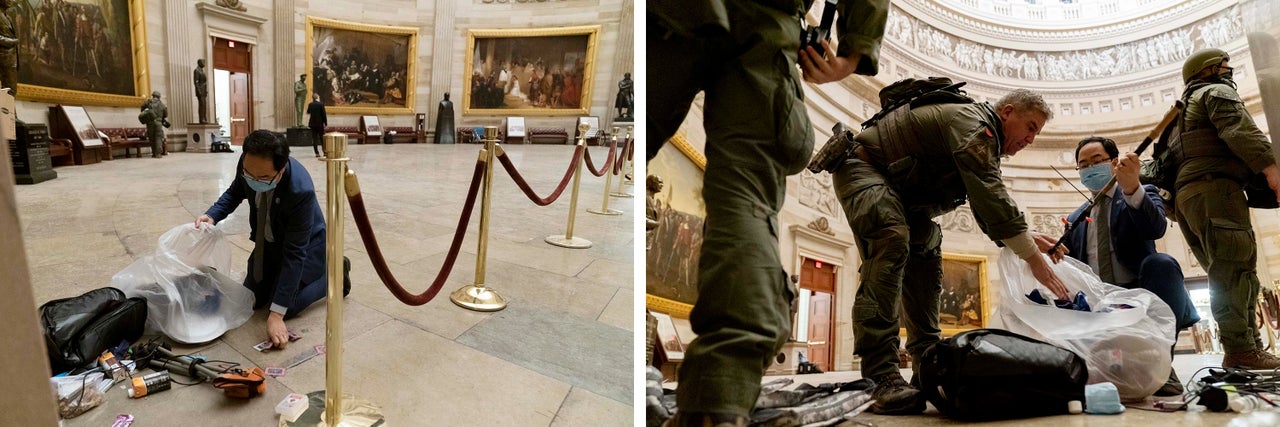
Q: Do you remember anyone taking a picture of you?
Kim: Not in the rotunda. I remember when I was in the Crypt, there was someone ― I guess it was probably the photographer — who said something to the effect of, “What are you doing?” I just said, “I’m just picking up trash.”
I was pretty focused on just dealing with the trauma of the day. I didn’t know what to make of it at the time. I’m someone who often tries to channel my anxieties and my stress into something productive.
After that interview, we started getting some more requests, and then my wife called me because someone had sent her the picture. I didn’t tell her about the photos, nor did I tell her I spent time cleaning. I told her people are starting to ask me for interviews about this, and my instinct was to say no. I didn’t think what I did was noteworthy.
But my wife said, it’s not about the magnitude of the impact of your action. She said what hit her when she saw it ― and this was irrelevant of me being in it ― but there was this one image of decency coming out from a day of tragedy and horrible images. There was this one image that stood out to her — an act of humility, of service.
So in that kind of vein, I was willing to talk about it. But it was hard. I did a lot of interviews, and I had to relive the experience of that day so viscerally. I would often have to just break down in tears between interviews just to try to recompose myself.
Maybe two or three days after the 6th, I was heading home. I remember picking my kids up from day care. My wife hadn’t told them what was happening. My kid just came up to me and said, “Dada, are you OK?” He could sense something had happened. He said, “Has something happened at your work?”
I kind of imagined that because of the image, maybe there was some talk among his teachers or something.
Then I took them home for the night and we were playing for a bit. I got them into bed, tucked them in. Then I received a phone call and it had a restricted number. I picked it up. Someone asked, “Is this Andy ― Andy Kim?” And I said, “Who’s asking?”
It was a person who refused to be identified but said we had friends in common. That’s how he got my number. He broke down crying on the phone and he said, “Look, I just want you to know, I’ve spent some time working on Capitol Hill before, and I love that building. And the image of you cleaning was all that got me through the last couple of days.”
He said that it really kind of showed him that leadership isn’t just about yelling and screaming, not just words, but it’s about service. ... I remember it being a very powerful experience, just sitting there in my living room talking to a total stranger.
I think I started to understand that the photo actually had some impact on people, and hopefully in a positive way. So I’ve felt like, if I can play that role of giving people some hope, and giving our country a sense of resilience, then that’s a role I’m willing to play.
Q: Did you hear from a lot more strangers?
Kim: I did. We received probably several thousand handwritten letters to the office, from all over the country. People drew pictures of the day and sent them to me. And that was something.
My team actually put together — just to kind of help memorialize it — put together a little scrapbook of some of the cards that people sent us.
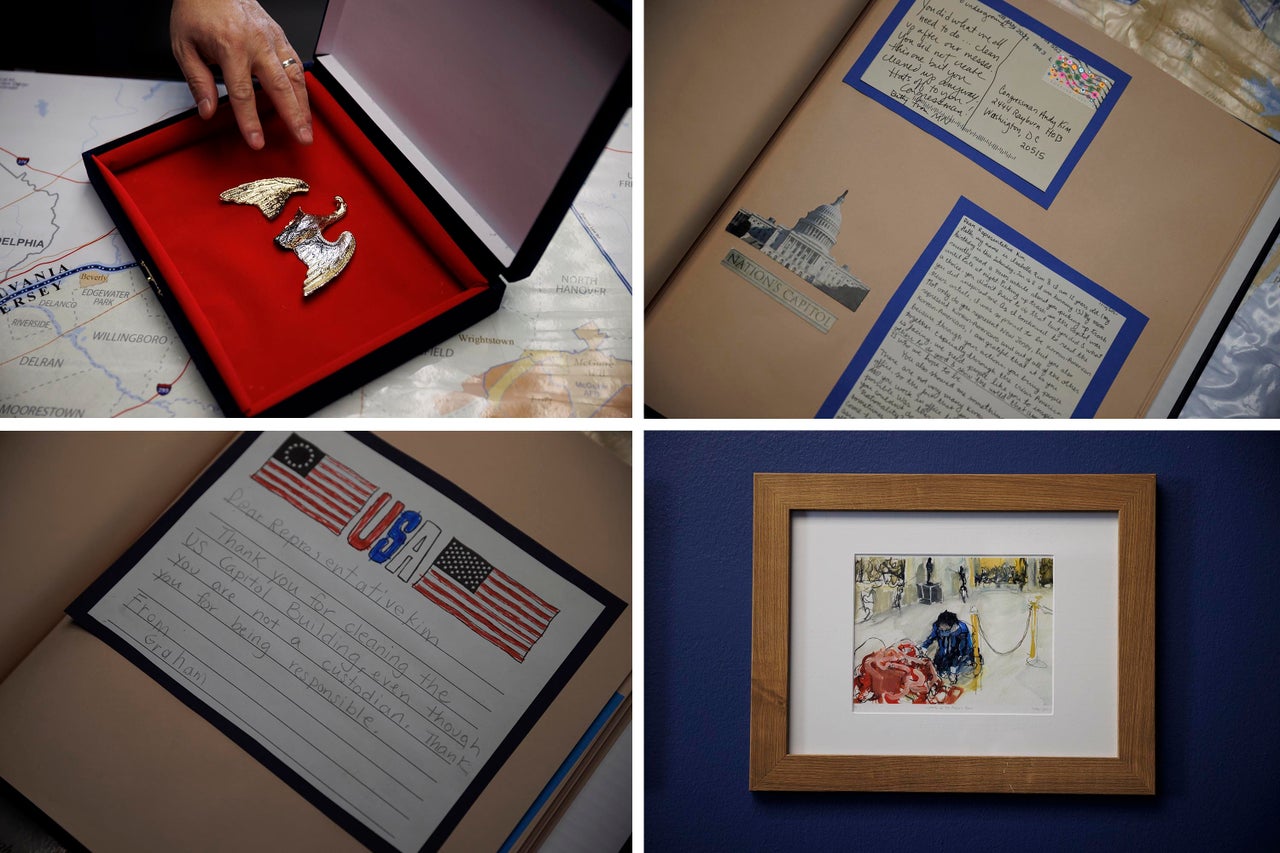
Q: How often do you think about Jan. 6?
Kim: Every day. Sometimes it’s just a passing thought. But I can’t be in the Capitol without thinking about it.
I really felt like I came to see my job as being a caretaker for this building and for our democracy. So I feel very protective of the Capitol.
It’s now integral to how I see my job. My job now revolves around a singular question, which is, how do we heal this country? So all the work I do, it’s all related to this idea about, how do we heal? It raises the question: Can we heal? I think that was a question I actually asked myself a couple of days after Jan. 6, when I saw thousands of uniformed service members all over the Capitol. But I want to believe that we can do it.
